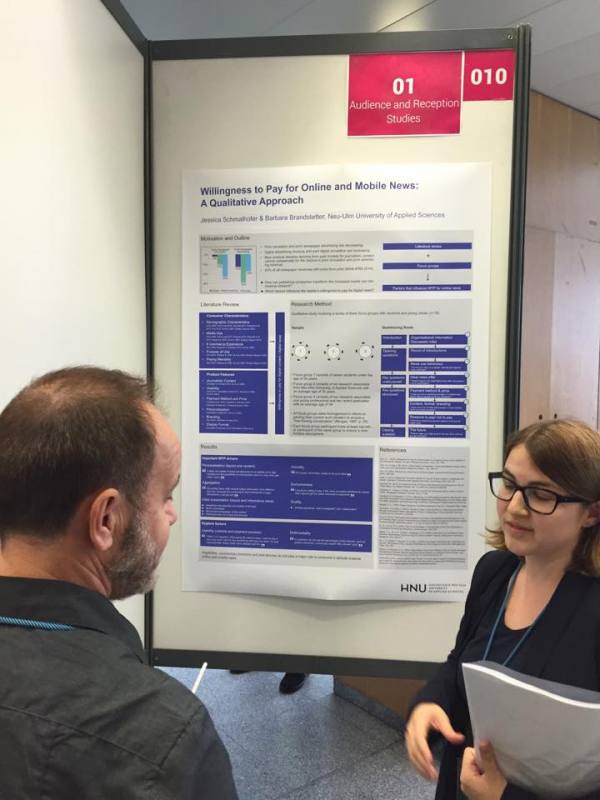The European Communication Conference, arranged by ECREA, begins officially tomorrow on Thursday. As per usual, there are numerous research posters covering all the major themes of the conferences, including journalism and journalism studies. These posters can be seen at Hall 4 and 5, First Floor.
We picked 10 most interesting posters based purely on their abstracts. Snippets from the abstracts are provided below, but be sure to visit ECC final program for the whole abstracts and more information.
 Willingness to pay for online news by Jessica Schmalhofer and Barbara Brandstetter
Willingness to pay for online news by Jessica Schmalhofer and Barbara Brandstetter
1. Safety of Journalists and the Issue of Impunity by Reeta Pöyhtäri & Ming-Kuok Lim
In the past 10 years, more than 600 journalists and media workers have been killed and majority of them not war zones. Attacks on media professionals are often perpetrated in non-conflict situations by organized crime groups, militia, security personnel, and even local police, making local journalists among the most vulnerable, note Pöyhtäri (University of Tampere) and Lim (UNESCO) in their thought-provoking poster.
Even more shocking is the fact that most abuses remain uninvestigated and unpunished. This might lead to more self-cencorship and less press freedom.
2. Interactivity on Newspaper Websites – Features and Determining Factors by Michael Hallermayer & Thomas N. Friemel
Hallermeyer and Friemel have examined how different interactivity features are implemented on newspaper websites.
They conducted a content analysis of 150 German and 44 Swiss newspaper websites and combined the data with the distribution range of the newspapers and their websites.
3. “False Confessions” in Media Coverage: The Case of Rudolf R. by Petra Hemmelmann, Melanie Verhovnik & Christian Klenk
Hemmelmann, Verhovnik and Klenk delve into the interesting case of Rudolf R. which was featured in numerous German media reports for over ten years.
The sensationalist story of Rudolf R. goes as follows. He was allegedly murdered and fed to farm dogs. According to a Guardian article he was “hacked to death with an axe by his wife, children and a family friend, his torso later fed to the family’s three pet dogs and his head boiled in an urn and buried in a heap of manure.”
Shocking, but not true. As the title suggests, this research focuses on the phenomenon of “false confessions.”
The research project examined the portrayals of the media players involved.
The results of the study show how problematic a speculative, sensationalist coverage of court cases can be and that background information is often missing.
4. Food (Safety) Scandals and the Media: a Survey of Journalists on Informative Processes Behind the Scene by Sabine Baudisch, Romy Fröhlich & Clarissa Schöller
Another poster focuses on scandalous news items as well. This one analyzes the media coverage of the so-called food scandals – horse-meat lasagna and others – in Western countries.
“How do informative processes around food production and food trade work?
Where do journalists get their information from and how does a typical research process on food-topics look like?
How do journalists assess the impact of their coverage on consumers’ behavior?
Baudisch, Fröhlich and Schöller interviewed 31 journalists from newspapers, trade magazines, broadcast and online media to find answer to these research questions.
5. Willingness to Pay for Online and MobileNews: A Qualitative Approach Jessica Schmalhofer & Barbara Brandstetter
Are readers willing to pay for online news? How can newspapers establish new streams of revenue online?
These ubiquitous questions is the essence of the research of Schmalhofer and Brandstetter.
They try to identify what kind of news readers are ready to pay for and which factors influence their decision to pay or not to pay. This project focused on German newsmarket.
“The results of our study show what publishing houses should do to generate new revenue streams online”, Schmalhofer and Branstetter promise in their abstract.